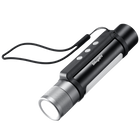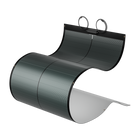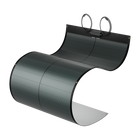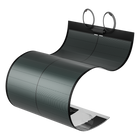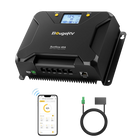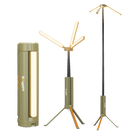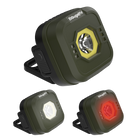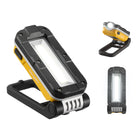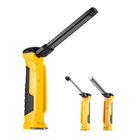What Is an Overland Vehicle? Features, Types, Benefits, and More!


The term "overlanding" has exploded in popularity among adventure enthusiasts and outdoor lovers. But what exactly is an overland vehicle, and why is it gaining such a loyal following? In this detailed blog post, we'll dive into the essence of overland vehicles, their key features, and why they're perfect for those who crave adventure off the beaten path.
Discover now!
What Exactly Is Overlanding?
Before diving into the specifics of overland vehicles, it's essential to understand what overlanding itself entails. Overlanding is a form of self-reliant travel that focuses on the journey rather than the destination. It involves long-distance travel to remote locations, often spanning international borders, with an emphasis on exploration and adventure. Unlike traditional road trips, overlanding requires you to be more self-sufficient, prepared for various terrains, and capable of handling unexpected challenges along the way.
So, What Is an Overland Vehicle?
An overland vehicle is specially designed or modified to handle the rigors of overlanding. These vehicles are built to navigate rough terrains, carry essential supplies, and provide a comfortable living space for extended periods away from civilization. While there is no one-size-fits-all definition, several key features distinguish overland vehicles from regular cars and trucks.
4 Key Features of an Overland Vehicle

Now, let's break down some of the key features of an overland vehicle:
1. Off-Road Capability
One of the most critical aspects of an overland vehicle is its off-road capability. These vehicles are engineered to tackle challenging terrains, including rocky trails, muddy paths, and sandy dunes. Key components that contribute to off-road performance include:
-
Four-Wheel Drive (4WD): Most overland vehicles come equipped with 4WD, allowing them to distribute power to all four wheels for better traction on uneven surfaces.
-
High Ground Clearance: Increased ground clearance helps you traverse obstacles without getting stuck or damaging your vehicle. For example, an overland vehicle with a clearance of around 8 to 10 inches is generally considered good for moderate off-roading, while more extreme conditions might require 10 to 12 inches or even higher.
-
All-Terrain Tires: Specialized tires with aggressive tread patterns enhance grip and stability on various surfaces.
-
Robust Suspension System
: A heavy-duty suspension system absorbs shocks and bumps, ensuring a smoother ride over rugged terrain.
2. Durability and Reliability
Overland journeys often take us far from urban areas, where roadside assistance might be unavailable. That's why durability and reliability are key when choosing an overland vehicle. These rigs are built to withstand harsh conditions and keep going, even when the going gets tough. Some common attributes include:
-
Reinforced Chassis: A sturdy chassis provides the structural integrity needed for our off-road adventures.
-
Skid Plates: Protective plates shield your vehicle's undercarriage from rocks and debris.
-
Extended Fuel Range: Larger fuel tanks or auxiliary fuel systems ensure you can travel longer distances between refueling stops.
3. Self-Sufficiency Features
Overland travelers need to be self-sufficient, often spending days or weeks away from civilization. As such, overland vehicles are equipped with various features to support extended stays in remote locations, including:
-
Storage Solutions: Ample storage space for food, water, and gear is crucial. Roof racks, cargo boxes, and interior shelving help maximize your storage capacity.
-
Water and Food Storage: Many overland vehicles come with built-in water tanks and refrigerators to store fresh food and drinking water.
-
Cooking Facilities: Portable stoves, heavy-duty fridges, grills, and kitchen setups allow you to prepare meals on the go.
-
Sleeping Arrangements: Whether it's rooftop tents, camper shells, or interior sleeping platforms, these setups provide comfortable sleeping quarters for us on the road.
-
Power Systems: Solar panels, dual battery systems, and inverters ensure we have electricity for lighting, cooking, and charging our electronic devices.
4. Recovery and Safety Equipment
Safety is a top priority when venturing into remote areas. Overland vehicles are typically outfitted with recovery and safety equipment to handle emergencies, including:
- Winch Systems: Winches help recover your vehicle if it gets stuck in mud, sand, or other challenging situations.
- Recovery Gear: Items such as tow straps, shackles, and traction boards assist you in vehicle recovery operations.
- First Aid Kits: Comprehensive first aid kits are essential for addressing medical emergencies.
- Communication Devices: Two-way radios, satellite phones, and GPS systems enable communication and navigation in remote regions.
Types of Overland Vehicles

Overland vehicles come in various shapes and sizes, each tailored to specific preferences and needs. Here are some popular types of overland vehicles:
1. SUVs
Sport Utility Vehicles (SUVs) are a common choice for overlanding due to their versatility and off-road capabilities. Popular models like the Toyota Land Cruiser, Jeep Wrangler, and Land Rover Defender are well-regarded in the overlanding community.
SUVs offer ample cargo space, comfortable interiors, and robust drivetrains, making them ideal for both short trips and extended expeditions.
2. Trucks
Trucks, especially mid-size and full-size pickups, are another favorite among overland enthusiasts. Models like the Ford F-150, Toyota Tacoma, and Chevrolet Colorado can be customized with camper shells, rooftop tents, and bed slides to create versatile overland rigs. Trucks excel in carrying heavy loads and towing trailers, providing additional flexibility for overland travel.
3. Vans
Vans, particularly those with four-wheel drive capabilities, have gained popularity as overland vehicles. The Mercedes-Benz Sprinter 4x4 and Ford Transit AWD are prime examples. Vans offers spacious interiors that can be converted into comfortable living spaces with beds, kitchens, and storage solutions, making them perfect for extended overland journeys.
4. Expedition RVs
Expedition RVs, also known as expedition trucks or overland rigs, are purpose-built vehicles designed specifically for Overlanding. These vehicles are often based on commercial truck chassis and feature fully integrated living quarters, off-road capabilities, and large fuel and water capacities. Brands like EarthRoamer and Global X Vehicles produce high-end expedition RVs that provide luxury and self-sufficiency in remote locations.
5. Motorcycles
For solo adventurers seeking a more minimalist approach, adventure motorcycles (ADV bikes) are an excellent option. Models like the BMW GS series, KTM Adventure, and Honda Africa Twin are designed for long-distance travel on and off-road. ADV riders can carry essential gear in panniers and enjoy the freedom and agility of two-wheeled overlanding.
Benefits of Overland Vehicles
Overland vehicles offer numerous advantages that make them appealing to adventure seekers. Here are some key benefits:
- Self-Sufficiency
Overland vehicles are equipped to support self-sufficient travel, allowing you to carry everything you need for extended journeys. This self-reliance reduces reliance on external resources and services.
- Comfort and Convenience
Modern overland vehicles prioritize comfort and convenience. With amenities like comfortable sleeping arrangements, cooking facilities, and climate control, you can enjoy the comforts of home while on the road.
- Adventure and Exploration
Overlanding opens up a world of adventure and exploration. You can access remote locations, national parks, and scenic routes that are often inaccessible by conventional means of travel. Every trip becomes an opportunity for discovery and unforgettable experiences.
- Community and Camaraderie
The overlanding community is a tight-knit and supportive group of like-minded individuals. Engaging with fellow overlanders through forums, social media groups, and events fosters camaraderie and the exchange of valuable knowledge and tips.
Customizing Your Overland Vehicle
While factory-built overland vehicles come with many essential features, customization allows you to tailor your rig to your specific needs and preferences. Here are some common customizations:
-
Suspension Upgrades: Upgrading the suspension system enhances off-road performance and ride comfort. You might want to consider adding heavy-duty shocks, coil springs, and sway bars to improve stability and handling.
- Lighting: Installing additional lighting, such as LED light bars and spotlights, significantly improves visibility during nighttime driving and off-road navigation.
-
Storage Solutions: Custom storage solutions can optimize the use of space in your vehicle. Drawer systems, roof racks, and cargo organizers help keep your gear organized and easily accessible.
-
Communications: Enhance your communication capabilities with CB radios, HAM radios, and satellite communication devices. These tools are invaluable for staying connected in remote areas.
-
Power Management: Investing in power management systems like solar panels, dual battery setups, and inverters ensures you have a reliable source of electricity for your equipment and appliances.
-
Security: Consider adding security features such as vehicle alarms, locking storage compartments, and GPS tracking systems to protect your investment and belongings.
Getting Started with Overlanding
If you're inspired to embark on your overlanding journey, here's a step-by-step guide to get started:
- Choose the Right Vehicle
Consider your budget, travel plans, and personal preferences when making your decision. Whether you opt for an SUV, truck, van, or motorcycle, ensure it meets the criteria for off-road capability and self-sufficiency.
- Plan Your Route
Research potential routes and destinations. Think about factors such as terrain difficulty, weather conditions, and available resources along the way. It's essential to plan for contingencies and have alternative routes in case of unexpected obstacles.
- Gather Essential Gear
Assemble the necessary gear and equipment for your journey. This includes camping gear, cooking supplies, recovery tools, communication devices, and first aid kits. Make a checklist to ensure nothing is overlooked.
- Bring a Heavy Duty Overland Fridge
One must-have for any overlanding adventure is a durable, heavy-duty fridge. Trust us, you don’t want to deal with melting ice and soggy food or hunt for ice packs miles away for a cooler.
A top-notch fridge, like BougeRV Rocky Series for Overland camping, keeps your meals fresh and drinks icy cold without the need for ice, allowing you to taste delicious, safe-to-eat food no matter where your journey takes you. This fridge can withstand rough rides and harsh bumps and jostles, so you won’t have to worry about a broken fridge ruining your great trip.
Whether you're:
- Navigating Mojave’s endless golden sand dunes, with your 4x4 cresting steep hills as the sunset paints the sky orange and pink,
- Tackling Colorado's rocky trails, where your vehicle’s suspension handles jostling paths, offering you stunning snow-capped peak views,
- Weaving through the Pacific Northwest’s muddy forest trails, with your tires gripping slick ground amidst towering pines as wildlife flits through the underbrush,
- Powering through Everglades' swampy terrain, with your car carving soggy ground while mangroves twist around you in a fairy-tale setting…
The Rocky remains unbeatable, with no breaks or cracks, keeping your food and drinks perfectly chilled every time! Plus, it stays quiet and stable whether it's in your rear cargo area, sliding out from a drawer system, tied down in your truck bed, or behind the front seat of your RV.
Think about grabbing a perfectly chilled drink and some meat to cook for dinner after a long day on the trail, all while enjoying an incredible view. How amazing is that?
- Practice and Prepare
Before embarking on a lengthy overland trip, practice your skills and test your equipment on shorter excursions. Familiarize yourself with vehicle recovery techniques, basic maintenance tasks, and emergency procedures.
- Stay Safe and Respectful
Safety should always be a top priority. Travel with caution, adhere to local regulations, and respect the environment and local communities. Leave no trace and minimize your impact on natural landscapes.
- Join the Community
Connect with the overlanding community to gain insights, share experiences, and seek advice. Online forums, social media groups, and overlanding events offer valuable opportunities to learn from experienced travelers.
By following these steps, you'll be well on your way to an unforgettable overlanding adventure that combines freedom, exploration, and a connection with nature and like-minded adventurers.
Final Thoughts
Whether you're traversing rugged trails, camping under the stars, or discovering remote corners of the world, an overland vehicle empowers you to embrace the journey and create lasting memories along the way.
So, if you've ever dreamed of hitting the open road and exploring the great outdoors, consider investing in an overland vehicle. With the right equipment, preparation, and mindset, you'll be ready to embark on the adventure of a lifetime!









